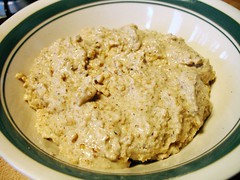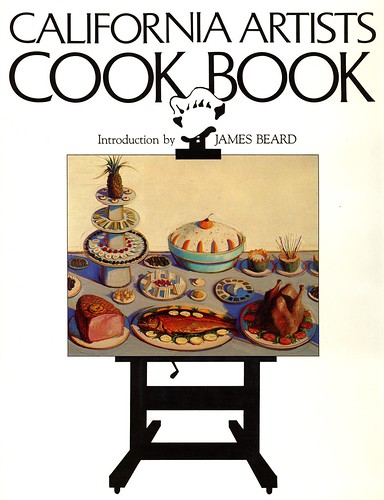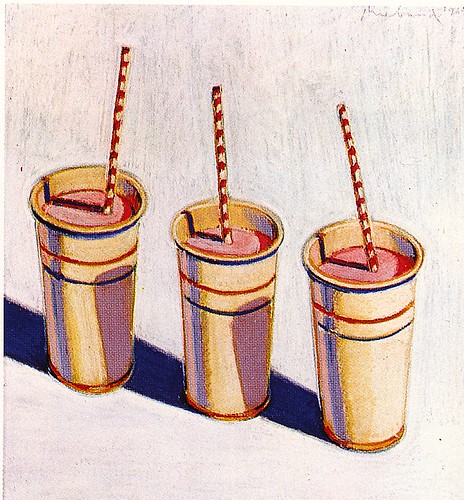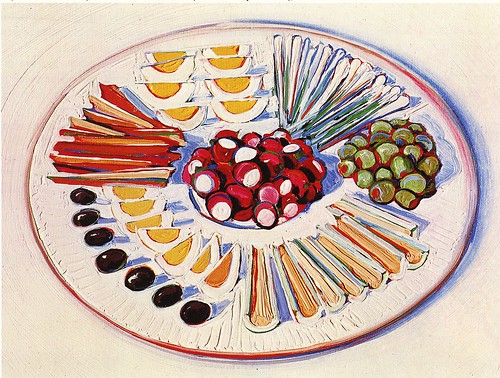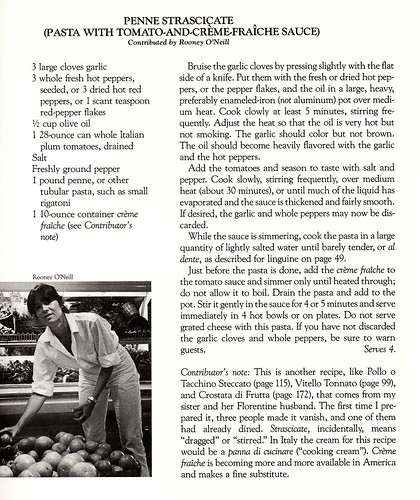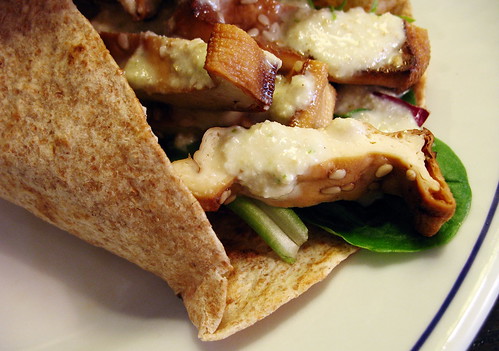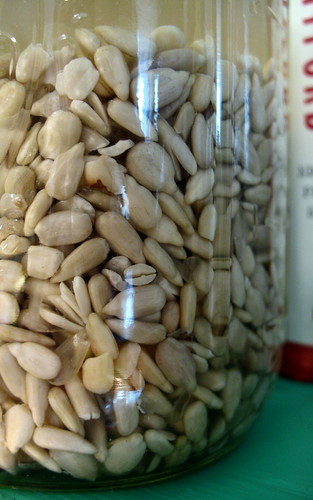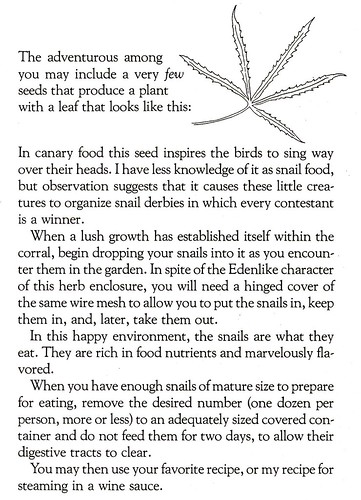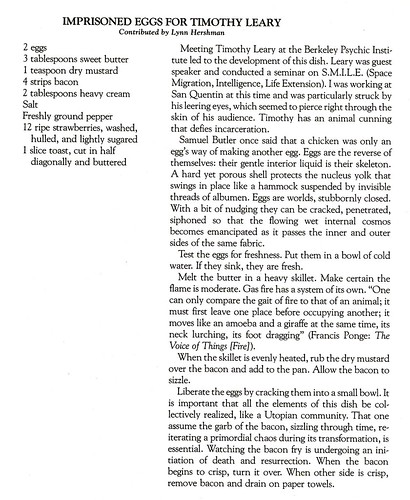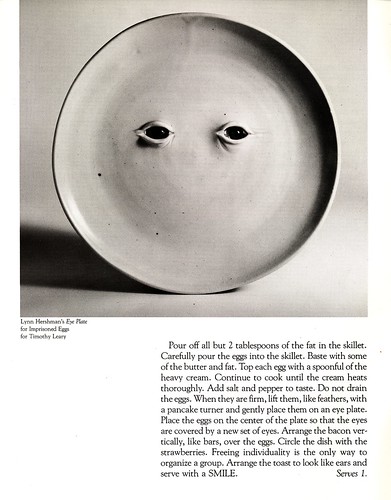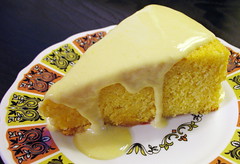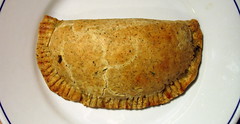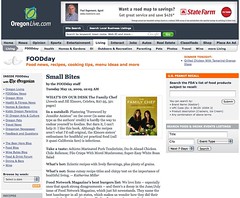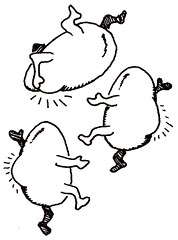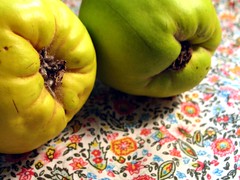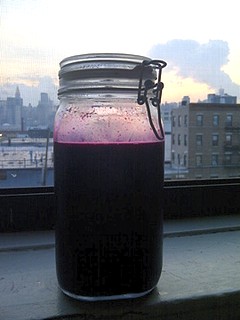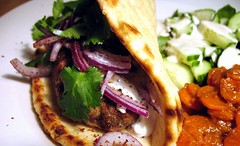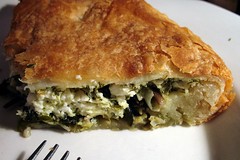pasta with walnut sauce
Long before I bothered to learn anything about cooking, I learned that I could "cook" (i.e. stir together) a relatively unusual and impressive pasta dinner at home with the help of a little tub of walnut sauce (salsa di noci) from Balducci's on Sixth Ave. I wish I'd scrutinized the list of ingredients more closely because other walnut sauces seem to use more ingredients and I don't enjoy them as much. In my memory Balducci's version was a dead-simple pesto-like preparation of finely chopped walnuts, olive oil, probably more salt than I would have dared to use on my own at the time, maybe a little garlic, and possibly some finely grated Parmesan (but not enough to be a dominant flavor).
Some cursory poking around the internet reveals that walnut sauce is Ligurian in origin and that there is little consensus about what goes into it besides the nuts. Most versions I've come across so far have cream in them and I can't quite bring myself to endorse the use of more than a tablespoon or two of it; my idea of a walnut sauce is that it's a little rough around the edges, and cream smooths out flavors as well as texture. Many are thickened with a slice of bread soaked in milk, which I don't think is necessary; it's already a very rich and thick sauce due to the nuts, and hardly needs any help to cling to pasta. Many contain a little fresh marjoram, which sounds nice but is at odds with my fond memories of eating herb-less walnut sauce in a slightly-creepy unheated loft in Williamsburg.
The last time I made my own walnut sauce I decided to give cream a try and I intended to use this recipe, but I just couldn't see adding Vin Santo or Moscato, both of which are sweet wines. Creamy, ok; sweet, absolutely not. Likewise, I was open to using a little fresh grated nutmeg but cinnamon seemed like it would take the sauce in a vaguely medieval direction and I didn't want to go there.
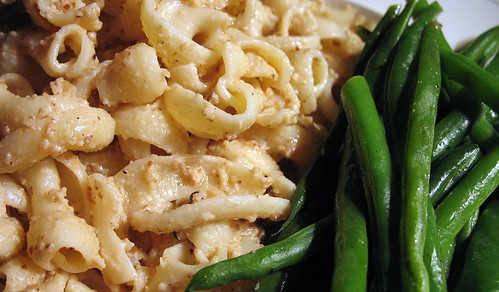
So, the preparation that follows is a compromise, and it's more of a sketch than a proper recipe. Further experimentation is needed, advice is welcome, and the subject will be revisited here as soon as it's revisited in my kitchen. As much as I like wine it doesn't belong in my ideal walnut sauce. The version in the Silver Spoon is closer to what I have in mind as definitive — it consists only of skinned walnuts, olive oil, a little cream (2 tablespoons), salt and white pepper — but I know I won't be happy until I work out a cream-less one for myself.
pasta with walnut sauce
Loosely adapted from here. You'll end up with more sauce than you need for 1 lb. of pasta, so stir it in gradually until you're satisfied with the way it coats the pasta and refrigerate the leftover sauce to use in assembling weird and unrepeatable sandwiches later in the week.
People who get emotional about garlic will roll their eyes at my use of one measly clove but I don't like using a lot of it; I like using a little that was grown by some happy-eyed hippie farmer who plants 20 or 30 varieties of it. Try to find someone like that reasonably close to where you live and see if their good shit doesn't change your outlook. I don't know enough about the various varieties to recommend one by name (and you probably wouldn't be able to shop that way even if I did) but I seem to have good results with ones that have very pink or very purple-streaked skin.
2 handfuls of walnuts
1 clove of garlic, green shoot removed if it's got one
sea salt and fresh ground pepper
a little freshly grated nutmeg
1/4 cup olive oil
1/4 cup white wine (Chardonnay or white Burgundy are good choices, nothing too oaky or too acidic)
2 tablespoons heavy cream, or more if you're into it
1 lb. pasta of your choice
Lightly toast the walnuts in a moderately hot oven or toaster oven and while they're still warm, rub them together in a clean dishcloth to remove as much of their skin as possible. (Don't worry if they crumble a bit because they're going into the food processor anyhow, but the larger the pieces, the easier it will be to get them out of the pile of skin). Coarsely chop the garlic, then pulse the walnuts and the garlic in a food processor until they are mealy in texture. The mixture should look more pesto than nut butter. Add the spices and the liquids and pulse or process just until everything comes together and begins to look like a sauce. It's not attractive. It'll look a little better when it's on the pasta so don't dwell on it.
Cook the pasta in salted water until it's done to your liking, drain it, and stir in spoonfuls of the walnut sauce until it's evenly but lightly coated.
Steamed green beans are very nice on the side. If you are thoughtful about pasta shapes, note that the Silver Spoon specifies fresh fettuccine (or boiled turnips!) for walnut sauce. Several other recipes suggest pairing it with meatless ravioli, either cheese or pumpkin. The pasta pictured above is maccheroni al torchio. No particular reason; it was there and needed to be used up.
slightly-buzzed oatmeal cookies
If your tastes shift with the seasons there's a relatively narrow window for cookies between the months after Christmas (when cranking out pan after pan of them feels appropriate but rapidly exhausts one's interest in them) and the months in which baking them becomes uninteresting (due to warm weather, the arrival of asparagus, other distractions). I was attracted to this recipe because I had a craving for oatmeal cookies and it looked suitably classic, but I couldn't resist fiddling with it a little. I only made one significant change to it but it gave the cookies a grown-up and slightly savory taste I really loved: I soaked the raisins in warm sherry until they had absorbed all they could. I forgot to write down which variety I used but I almost always buy Amontillado unless I have some particular reason to use another because I like it for both drinking and cooking. For this recipe I think you'd be fine with anything other than a very pale Fino, which would be too dry and probably too subtle to pair with the walnuts and spices. If you happen to have some cognac it might be worth a try in place of the sherry. Sorry about not taking a photo; somehow all the cookies got eaten before that could happen.
slightly-buzzed oatmeal cookies
The following recipe is very slightly adapted from the Oct. 2004 one from Real Simple linked to above. (I shifted the order of ingredients so that you don't forget to soak the raisins before proceeding with the rest, and I made a few notes in brackets). Makes about 2 dozen cookies.
1/2 cup raisins [I used golden raisins]
[enough sherry to cover the raisins, approx. 1/2 cup; see comments above as to which variety]
3/4 cup brown sugar
1/2 cup unsalted butter (1 stick), softened [I used salted because I like salt, and I used a little extra for the pan rather than the cooking spray called for in the instructions below]
1 1/4 cups oatmeal [rolled oats are perfect]
1 egg
3 tablespoons whole milk
1 cup all-purpose flour
1/2 teaspoon baking soda
1 teaspoon cinnamon
1/2 teaspoon ground cloves [I ground whole cloves in a spice grinder; unless you cook with cloves a lot your pre-ground ones probably aren't very fresh, and it only takes a minute to grind them]
1/4 teaspoon salt
1/2 cup walnuts, chopped [I used a bit more]
1/2 teaspoon vanilla extract
[Heat the sherry in a saucepan until it's warm but not simmering and pour it over the raisins. You can do this in the morning and leave them to soak until you're ready to bake. If you forget, try to let them soak at least 30 minutes before you start baking.] Preheat oven to 375° F. Lightly coat a baking sheet with cooking spray [or softened butter]. In a medium mixing bowl, combine the brown sugar and butter until well blended. Add the oatmeal, egg, and milk, stirring well. In a small bowl, stir together the flour, baking soda, cinnamon, cloves, and salt. Gradually add to the oatmeal mixture, stirring well. Stir in the walnuts, raisins, and vanilla. Drop the dough by tablespoonfuls, spaced about 1 inch apart, onto the baking sheet. Bake for 8 to 10 minutes. Transfer the cookies to a wire rack to cool. Repeat with the remaining dough. [I baked the cookies an additional 5 minutes or so and didn't regret it. I think this was necessary because I had two pans in the oven at once, and opened the door mid-way through the first 10 minutes to reverse their positions.]
walnut, fennel seed and raisin scones
I made this recipe years ago and never got around to writing about it, but it's really good and I pause whenever I scroll past it in my recipe collection. I don't buy scones often because they're usually too sweet and I don't make them often because they don't do enough for me taste-wise to earn their calories, but these have a nice herbal edge courtesy of fennel seeds. They're especially good warm.
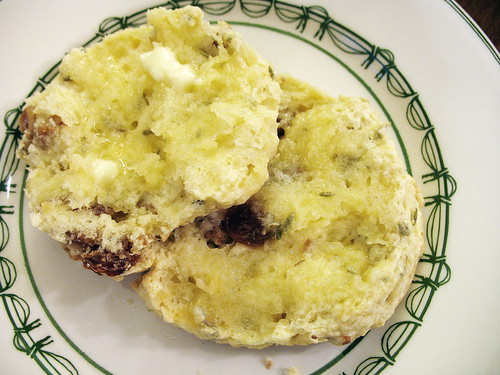
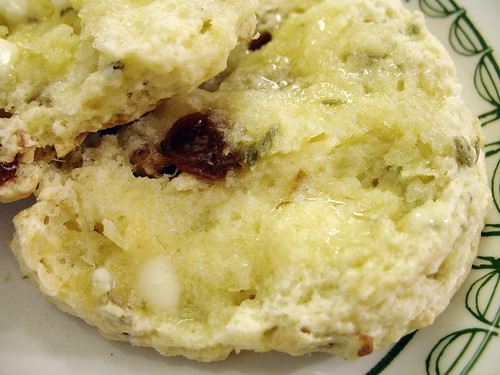
The recipe below is from Bon Appétit here. It makes 12 scones.
2 cups all purpose flour
1/3 cup sugar
2 teaspoons baking powder
1/2 teaspoon salt
6 tablespoons chilled unsalted butter, cut into 1/2-inch cubes
2 large egg yolks
1/2 cup buttermilk
1/2 cup golden raisins [other dried fruits could work too, or maybe fresh diced apple]
1/3 cup chopped toasted walnuts
1 tablespoon fennel seeds
1 large egg beaten to blend with 1 tablespoon water (for glaze)
Preheat oven to 400°F. Butter large baking sheet. Whisk flour, sugar, baking powder, and salt in large bowl to blend. Add butter. Using fingertips, blend mixture until coarse meal forms. Whisk egg yolks and buttermilk in small bowl to blend. Slowly stir egg mixture into flour mixture. Gently stir in raisins, walnuts, and fennel seeds. Turn dough out onto lightly floured work surface and knead gently just until smooth, about 4 turns. Divide dough in half; pat each half into 6-inch round. Cut each round into 6 wedges. Transfer scones to prepared baking sheet. Brush with egg glaze. Bake until scones are light brown, about 17 minutes. Serve warm or at room temperature. [No, serve them warm! Unless you have a scone every morning there's no reason to be blasé about this.]
